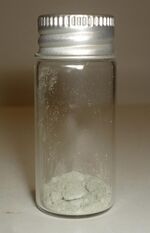N-(1-Naphthyl)ethylenediamine
Topic: Chemistry
 From HandWiki - Reading time: 3 min
From HandWiki - Reading time: 3 min

| |

| |
| Names | |
|---|---|
| Preferred IUPAC name
N1-(Naphthalen-1-yl)ethane-1,2-diamine | |
| Other names
N-1-Naphthyl-1,2-ethanediamine
Naphthylethylenediamine | |
| Identifiers | |
3D model (JSmol)
|
|
| 2803527 | |
| ChEBI | |
| ChEMBL | |
| ChemSpider | |
| EC Number |
|
PubChem CID
|
|
| UNII | |
| |
| |
| Properties | |
| C12H14N2 | |
| Molar mass | 186.258 g·mol−1 |
| Appearance | Off-white crystals (dihydrochloride) |
| Odor | Odorless |
| Density | 380 kg/m3 (dihydrochloride) |
| 30 g/1000 mL (dihydrochloride, 20 °C) | |
| Hazards[2] | |
| Main hazards | Irritant |
| GHS pictograms | 
|
| GHS Signal word | Warning |
| H315, H319 | |
| PP264Script error: No such module "Preview warning".Category:GHS errors, PP280Script error: No such module "Preview warning".Category:GHS errors, PP302+P352Script error: No such module "Preview warning".Category:GHS errors, P305+351+338, PP332+P313Script error: No such module "Preview warning".Category:GHS errors, PP337+P313Script error: No such module "Preview warning".Category:GHS errors | |
| NFPA 704 (fire diamond) | |
| Flash point | Nonflammable |
Except where otherwise noted, data are given for materials in their standard state (at 25 °C [77 °F], 100 kPa). | |
| Infobox references | |
N-(1-Naphthyl)ethylenediamine is an organic compound. It is commercially available as part of Griess reagents, which find application in quantitative inorganic analysis of nitrates, nitrite and sulfonamide in blood, using the Griess test.
Preparation
This compound can be prepared by the reaction of 1-naphthylamine with 2-chloroethanamine. It is commercially available as the dihydrochloride salt.
Properties
N-(1-Naphthyl)ethylenediamine undergoes most reactions typical to naphthylamine and primary amines such as diazotation. Similar to its analog ethylenediamine, it can also act as a bidentate ligand to give several coordination compounds. However, it is a weaker bidentate ligand as the nitrogen atom in the naphthylamine group is weakly coordinating due to the dispersal of charge by resonance. For example, it reacts with potassium tetrachloroplatinate in aqueous solution to give (N-1-naphthyl-ethylenediamine)-dichloroplatinum(II).[3]
Uses
N-(1-Naphthyl)ethylenediamine dihydrochloride is widely used in the quantitative analysis of nitrate and nitrite in water samples by colorimetry. It readily undergoes a diazonium coupling reaction in the presence of nitrite to give a strongly colored azo compound. Sample containing nitrite ions is first neutralized and then treated with dilute hydrochloric acid at 0 - 5 °C to give nitrous acid. Then an excess but fixed volume of sulfanilamide and N-(1-naphthyl)ethylenediamine dihydrochloride solution is added. With nitrous acid as the limiting reagent, the azo coupling reaction produces an azo dye quantitatively with respect to the nitrite ions:
The diazo compound formed accounts for the red coloration typical for a positive result. The color intensity of the resulting solution is then measured by a colorimeter and checked against a calibration curve to determine the nitrite ion concentration.[4]
To analyze nitrate concentrations quantitatively, the sample is first passed through a copper-cadmium column to reduce the nitrate ions quantitatively to nitrite ions, and the above procedure can be employed. However, the result should be adjusted for the nitrite ions present in the original sample.[5]
This method can be applied in many aspects, including determining the nitrate/nitrite concentrations in sewage or other biological samples such as intracellular fluids, given that the sample is clear and colorless.
In a similar protocol, the levels of sulfonamide in blood can be detected similarly with the same principles.
References
- ↑ Chemicals and reagents, 2008-2010, Merck
- ↑ "N-(1-Naphthyl)-ethylendiamin -dihydrochlorid". https://www.sigmaaldrich.com/AU/en/product/SIAL/222488.
- ↑ Horst Kunkely, Arnd Vogler (2002). "Synthesis and Electronic Spectra of (N-1-Naphthyl-ethylenediamine)-dichloroplatinum(II). Fluorescence of the Appended Naphthyl Substituent". Z. Naturforsch. 57b: 709–711.
- ↑ G. H. Jerffery; J. Bassett; J. Mendham; R. C. Denney (1989). "Colorimetry and Spectrophotometry". Vogel's Textbook of Quantitative Chemical Analysis, 5th Edition. Longman. p. 702. ISBN 0-582-44693-7.
- ↑ [1], Nitrate analysis protocol and principles.
 |
 KSF
KSF

